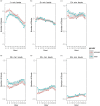Gender and Age Differences in Hourly and Daily Patterns of Sedentary Time in Older Adults Living in Retirement Communities
- PMID: 26296095
- PMCID: PMC4546658
- DOI: 10.1371/journal.pone.0136161
Gender and Age Differences in Hourly and Daily Patterns of Sedentary Time in Older Adults Living in Retirement Communities
Abstract
Background: Total sedentary time varies across population groups with important health consequences. Patterns of sedentary time accumulation may vary and have differential health risks. The purpose of this study is to describe sedentary patterns of older adults living in retirement communities and illustrate gender and age differences in those patterns.
Methods: Baseline accelerometer data from 307 men and women (mean age = 84±6 years) who wore ActiGraph GT3X+ accelerometers for ≥ 4 days as part of a physical activity intervention were classified into bouts of sedentary time (<100 counts per minute). Linear mixed models were used to account for intra-person and site-level clustering. Daily and hourly summaries were examined in mutually non-exclusive bouts of sedentary time that were 1+, 5+, 10+, 20+, 30+, 40+, 50+, 60+, 90+ and 120+ minutes in duration. Variations by time of day, age and gender were explored.
Results: Men accumulated more sedentary time than women in 1+, 5+, 10+, 20+, 30+, 40+, 50+ and 60+ minute bouts; the largest gender-differences were observed in 10+ and 20+ minute bouts. Age was positively associated with sedentary time, but only in bouts of 10+, 20+, 30+, and 40+ minutes. Women had more daily 1+ minute sedentary bouts than men (71.8 vs. 65.2), indicating they break up sedentary time more often. For men and women, a greater proportion of time was spent being sedentary during later hours of the day than earlier. Gender differences in intra-day sedentary time were observed during morning hours with women accumulating less sedentary time overall and having more 1+ minute bouts.
Conclusions: Patterns identified using bouts of sedentary time revealed gender and age differences in the way in which sedentary time was accumulated by older adults in retirement communities. Awareness of these patterns can help interventionists better target sedentary time and may aid in the identification of health risks associated with sedentary behavior. Future studies should investigate the impact of patterns of sedentary time on healthy aging, disease, and mortality.
Conflict of interest statement
Figures


Similar articles
-
Sedentary Bout Durations Are Associated with Abdominal Obesity in Older Adults.J Nutr Health Aging. 2015 Oct;19(8):798-804. doi: 10.1007/s12603-015-0501-4. J Nutr Health Aging. 2015. PMID: 26412283
-
The association between retirement and age on physical activity in older adults.Age Ageing. 2014 May;43(3):386-93. doi: 10.1093/ageing/aft168. Epub 2013 Oct 29. Age Ageing. 2014. PMID: 24171945
-
Associations between objectively-measured sedentary behaviour and physical activity with bone mineral density in adults and older adults, the NHANES study.Bone. 2014 Jul;64:254-62. doi: 10.1016/j.bone.2014.04.009. Epub 2014 Apr 13. Bone. 2014. PMID: 24735973
-
Associations of accelerometer-based sedentary bouts with adiposity markers among German adults - results from a cross-sectional study.BMC Public Health. 2023 Mar 10;23(1):469. doi: 10.1186/s12889-023-15304-8. BMC Public Health. 2023. PMID: 36899317 Free PMC article. Clinical Trial.
-
Patterns of Sedentary Behavior among Older Adults in Care Facilities: A Scoping Review.Int J Environ Res Public Health. 2021 Mar 8;18(5):2710. doi: 10.3390/ijerph18052710. Int J Environ Res Public Health. 2021. PMID: 33800199 Free PMC article.
Cited by
-
Diurnal patterns of sedentary behavior and changes in physical function over time among older women: a prospective cohort study.Int J Behav Nutr Phys Act. 2020 Jul 9;17(1):88. doi: 10.1186/s12966-020-00992-x. Int J Behav Nutr Phys Act. 2020. PMID: 32646435 Free PMC article.
-
Accelerometer-measured physical activity and sedentary behavior in nonagenarians: Associations with self-reported physical activity, anthropometric, sociodemographic, health and cognitive characteristics.PLoS One. 2023 Dec 6;18(12):e0294817. doi: 10.1371/journal.pone.0294817. eCollection 2023. PLoS One. 2023. PMID: 38055660 Free PMC article.
-
Time-varying associations between loneliness and physical activity: Evidence from repeated daily life assessments in an adult lifespan sample.Front Psychol. 2023 Jan 26;13:1021863. doi: 10.3389/fpsyg.2022.1021863. eCollection 2022. Front Psychol. 2023. PMID: 36778170 Free PMC article.
-
Behavioral Conformity of Physical Activity and Sedentary Behavior in Older Couples with One Partner Suffering from End-Stage Osteoarthritis.Clin Interv Aging. 2020 Jan 17;15:61-74. doi: 10.2147/CIA.S222490. eCollection 2020. Clin Interv Aging. 2020. PMID: 32021134 Free PMC article.
-
Rise and Recharge: Exploring Employee Perceptions of and Contextual Factors Influencing an Individual-Level E-Health Smartphone Intervention to Reduce Office Workers' Sedentary Time at Work.Int J Environ Res Public Health. 2021 Sep 13;18(18):9627. doi: 10.3390/ijerph18189627. Int J Environ Res Public Health. 2021. PMID: 34574551 Free PMC article.
References
-
- Thorp A, Dunstan D, Clark B, Gardiner P, Healy G, Keegel T, et al. Stand Up Australia: Sedentary behaviour in workers. 2009;
Publication types
MeSH terms
Grants and funding
LinkOut - more resources
Full Text Sources
Other Literature Sources
Medical

